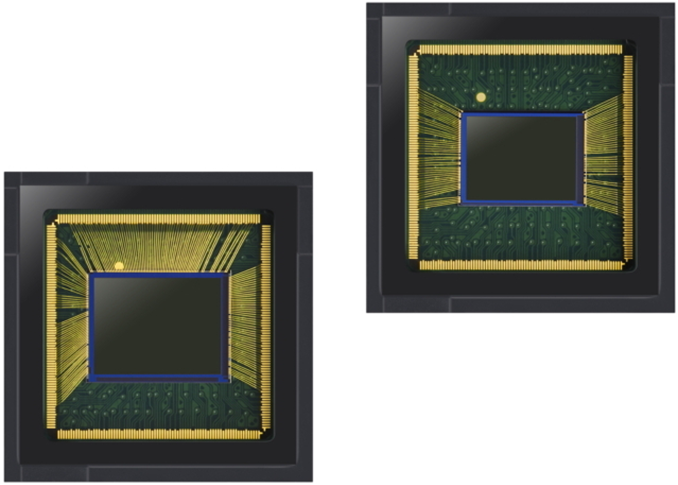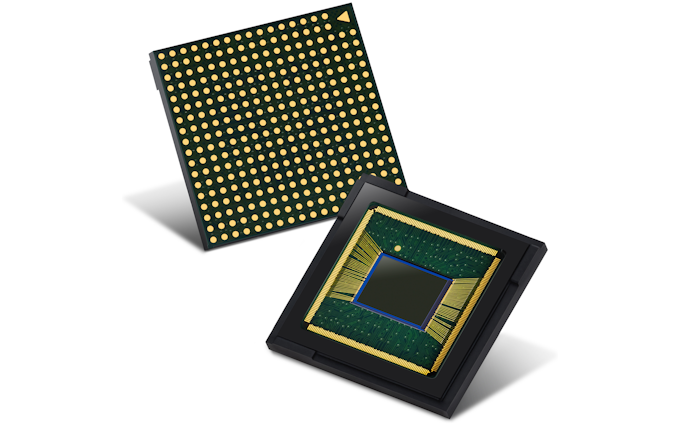Samsung Unveils 64 MP & 48 MP ISOCELL Bright Image Sensors for Smartphones
by Anton Shilov on May 9, 2019 12:00 PM EST- Posted in
- Smartphones
- Digital Camera
- Samsung
- Mobile

Samsung has introduced two new 0.8-μm image sensors for use in upcoming smartphones. The new sensors are the 48 MP ISOCELL Bright GM2 for advanced handsets as well as the 64 MP ISOCELL Bright GW1 for flagship phones. Both 0.8-μm image sensors not only feature very high resolutions via use of very small pixels, but they support a number of technologies designed to improve image quality.
Samsung’s new flagship 64 MP ISOCELL Bright GW1 0.8 μm image sensor features the industry’s smallest pixel for current smartphone sensors. It also supports the company’s 2x2 pixel-binning Tetracell technology, which merges four pixels into one to produce bright 16 MP photos. The technology explains that the sensor colour filters are actually arranged in a 4x4 subpixel arrangement, meaning chroma resolution is at a native 16MP. Samsung however also is able to support a re-mosaic algorithm to make full 64MP resolution images in bright conditions. Other features of the GW1 include Dual Conversion Gain (DCG) that optimizes its full well capacity (FWC) in well-lit environments, and speedy Super PD phase detection auto-focus technology.
The GW1 also supports a real-time dynamic range of up to 100 dB. Just to put the number in context, the human eye can distinguish hues of around 120 dB (according to Samsung), whereas current-generation sensors are all below this and tend to have highly varied dynamic ranges. (Samsung for its part puts the industry average at 60 dB, though this seems a bit low for high-end sensors)
Meanwhile the 48 MP ISOCELL Bright GM2 sensor has the same feature set as the GW1 (Tetracell, re-mosaic, DCG, and Super PC), but uses a smaller 1/2" sensor, versus the much larger 1/1.72" GW1.
The GW1's large sensor size equals that of Huawei's 40MP sensors designed by Sony. Here a big compromise of the big size is that vendors would either have to drop OIS or implement designs with larger camera bumps in order to accomodate the bigger optics required for the large sensor.
Samsung is sampling its ISOCELL Bright GW1 and GM2 with customers and plans to mass produce them in the second half of the year.
Related Reading:
- The Samsung Galaxy S10+ Snapdragon & Exynos Review: Almost Perfect, Yet So Flawed
- Google Rolls Out Night Sight Tech to Improve Quality of Low-Light Photos
- The Google Pixel 3 Review: The Ultimate Camera Test
- Google Announces Pixel 3a & Pixel 3a XL: Mid-Range Phones With Flagship Camera
- Nokia Launches Nokia 9 PureView at MWC 2019: So I Heard You Like Cameras
- Nokia 9 PureView: Hands On, Impressions, Thoughts
- Moto Z Hasselblad True Zoom Mod: Camera Shootout
Source: Samsung











17 Comments
View All Comments
BedfordTim - Thursday, May 9, 2019 - link
Colour information tends to be lower spatial frequency, so it isn't as bad as it looks. The tiny pixels are more of an issue as noise degrades colour in dark areas very effectively.johannesburgel - Thursday, May 9, 2019 - link
Every time some camera chip manufacturer expresses dynamic range in decibels instead of EVs you know they're lying. It's a neat way to cheat by picking a single SNR value in the blacks, where you can easily go beyond 100 dB, while the same sensor performs dramatically worse when measured across the full spectrum.No optical system with at least one lens in front of the sensor has ever achieved more than 100 dB. The best Nikon DSLR sensors can do about ~85 dB. This toy here probably can't even go beyond the simple lightbox setups which are used to test sensors in the range up to 35 dB.
saratoga4 - Thursday, May 9, 2019 - link
That number is not SNR, it is dynamic range, which is the ratio of the read noise in the sensor (typically 3 or 4 photons) to the maximum number of photons the sensor can detect without saturation. dB is the standard unit for dynamic range in sensor characterization. Since they're talking about dual conversion gain (essentially, an option to link an extra capacitor to each pixel), dynamic range can be enormous.100dB for just a sensor is not very high (you can buy lots of sensors higher than that), although it is impressive given the very small pixel size.
zodiacfml - Friday, May 10, 2019 - link
useless megapixel race. good thing, the sensor is quite large at 1/1.7. but then, it won't be even able to resolve detail like a 16 MP APSC sensor camera.saratoga4 - Friday, May 10, 2019 - link
Small form factor cameras like this generally have much higher detail than larger format sensors due to the very short back focal length. Some current generation cameras will produce an angular resolution that is not even physically possible on a 16 MP APS-C sensor.mkozakewich - Saturday, May 11, 2019 - link
Images from most small cameras like this can be reduced 50% in each dimension without actually losing any detail. If the new sensor is as good, then it'll pick up a commendable 16 MP, but for some reason I'm not getting my hopes up.saratoga4 - Saturday, May 11, 2019 - link
This is incorrect. Modern cellphone lenses have MTFs that are close to the diffraction limit (which isn't too surprising, they typically have 6+ aspherical surfaces and a flange distance of < 1 mm, and lens which are designed specifically for the sensor), so if you try to decimate by 2, you'll get both a substantial loss of detail and aliasing.